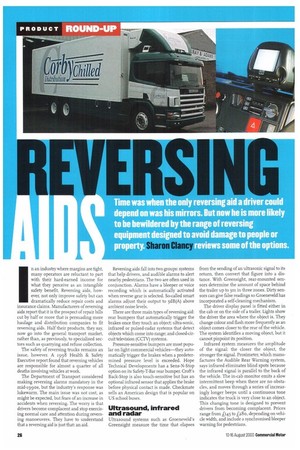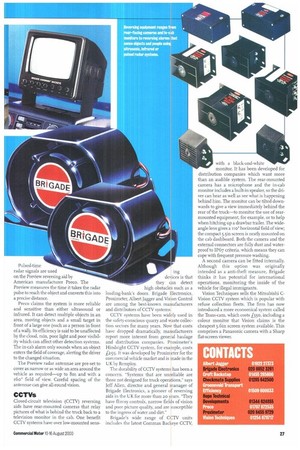Time was when the only reversing aid a driver could
Page 28

Page 29

If you've noticed an error in this article please click here to report it so we can fix it.
depend on was his mirrors. But now he is more likely to be bewildered by the range of reversing
equipme avoid damage to people or propert Sharon Clanc reviews some of the options.
n an industry where margins are tight, many operators are reluctant to part with their hard-earned income for what they perceive as an intangible safety benefit. Reversing aids, however, not only improve safety but can dramatically reduce repair costs and insurance claims. Manufacturers of reversing aids report that it is the prospect of repair bills cut by half or more that is persuading more haulage and distribution companies to fit reversing aids. Half their products, they say, now go into the general transport market, rather than, as previously, to specialised sectors such as quarrying and refuse collection.
The safety of reversing trucks remains an issue, however. A 1998 Health SE. Safety Executive report found that reversing vehicles are responsible for almost a quarter of all deaths involving vehicles at work.
The Department of Transport considered making reversing alarms mandatory in the mid-1990s, but the industry's response was lukewarm. The main issue was not cost, as might he expected, but fears of an increase in accidents when reversing. The worry is that drivers become complacent and stop exercising normal care and attention during reversing manoeuvres. They have to understand that a reversing aid is just that: an aid. Reversing aids fall into two groups: systems that help drivers, and audible alarms to alert nearby pedestrians. The two are often used in conjunction. Alarms have a bleeper or voice recording which is automatically activated when reverse gear is selected. So-called smart alarms adjust their output to 5dB{A) above ambient noise levels.
There are three main types of reversing aid: rear bumpers that automatically trigger the brakes once they touch an object; ultra-sonic, infrared or pulsed-radar systems that detect objects which come into range; and closed-circuit television (CCTV) systems.
Pressure-sensitive bumpers are most popular on light commercial vehicles—they automatically trigger the brakes when a predetermined pressure level is exceeded. Hope Technical Developments has a Sens-N-Stop option on its Safety-T-Bar rear bumper. Croft's Back-Stop is also touch-sensitive but has an optional infrared sensor that applies the brake before physical contact is made. Checkmate sells an American design that is popular on US school buses.
Ultrasound, infrared and radar
Ultrasound systems such as Groeneveld's Greensight measure the time that elapses from the sending of an ultrasonic signal to its return, then convert that figure into a distance. With Greensight, rear-mounted sensors determine the amount of space behind the trailer up to 3m in three zones. Dirty sensors can give false readings so Groeneveld has incorporated a self-cleaning mechanism.
The driver display panel is fitted either in the cab or on the side of a trailer. Lights show the driver the area where the object is. They change colour and flash more frequently as an object comes closer to the rear of the vehicle. The system identifies a moving object, but it cannot pinpoint its position.
Infrared system measures the amplitude of the signal: the closer the object, the stronger the signal. Proximeter, which manufactures the Audible Rear Warning system, says infrared eliminates blind spots because the infrared signal is parallel to the back of the vehicle. The in-cab monitor emits a slow intermittent beep when there are no obstacles, and moves through a series of increasingly longer beeps until a continuous tone indicates the truck is very close to an object. This changing tone is designed to prevent drivers from becoming complacent. Prices range from L145 to /280, depending on vehicle width, and include a synchronised bleeper warning for pedestrians.
Pulsed-time radar signals are used on the Preview reversing aid by American manufacturer Preco. The Preview measures the time it takes the radar pulse to reach the object and converts this into a precise distance.
Preco claims the system is more reliable and sensitive than either ultrasound or infrared. It can detect multiple objects in an area, moving objects and a small target in front of a large one (such as a person in front of a wall). its efficiency is said to be unaffected by the cloud, rain, poor light and poor visibility which can affect other detection systems. The in-cab alarm only sounds when an object enters the field of coverage, alerting the driver to the changed situation.
The Preview radar antennae are pre-set to cover as narrow or as wide an area around the vehicle as required—up to 8m and with a r6o° field of view. Careful spacing of the antennae can give all-round vision.
CCTIfs
Closed-circuit television (CCTV) reversing aids have rear-mounted cameras that relay pictures of what is behind the truck back to a television monitor in the cab. One benefit CCTV systems have over low-mounted sens ing devices is that they can detect
high obstacles such as a loading-bank's doors. Brigade Electronics, Proximeter, Albert Jagger and Vision Control are among the best-known manufacturers and distributors of-CCTV systems.
CCTV systems have been widely used in the safety-conscious quarry and waste collection sectors for many years. Now that costs have dropped dramatically, manufacturers report more interest from general haulage and distribution companies. Proximeter's Hindsight CCTV system, for example, costs f2 9 5. It was developed by Proximeter for the commercial vehicle market and is made in the UK by Remploy.
The durability of CCTV systems has been a concern. 'Systems that are unreliable are those not designed for truck operations," says Jeff Allen, director and general manager of Brigade Electronics, a pioneer of reversing aids in the UK for more than 20 years. "They have flimsy controls, narrow fields of vision and poor picture quality, and are susceptible to the ingress of water and dirt."
Brigade's wide range of CCTV units includes the latest Commax Backeye CCTV, with a black-and-white monitor. It has been developed for distribution companies which want more than an audible system. The rear-mounted camera has a microphone and the in-cab monitor includes a built-in speaker, so the driver can hear as well as see what is happening behind him. The monitor can be tilted downwards to give a view immediately behind the rear of the truck—to monitor the use of rearmounted equipment, for example, or to help when hitching up a drawbar trailer. The wideangle lens gives a fro horizontal field of view; the compact 5.5in screen is neatly mounted on the cab dashboard. Both the camera and the external connectors are fully dust and waterproof to IP67 criteria, which means they can cope with frequent pressure washing.
A second camera can be fitted internally. Although this option was originally intended as a anti-theft measure, Brigade thinks it has potential for international operations, monitoring the inside of the vehicle for illegal immigrants.
Vision Techniques sells the Mitsubishi CVision CCTV system which is popular with refuse collection fleets. The firm has now introduced a more economical system called the Trans-cam, which costs L'55o, including a colour monitor that Vision claims is the cheapest 5.6in screen system available, This comprises a Panasonic camera with a Sharp flat-screen viewer.








































































































